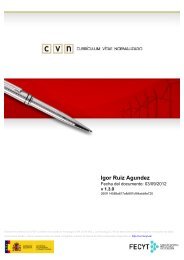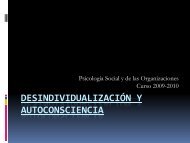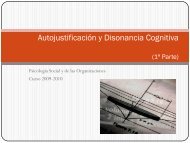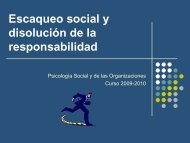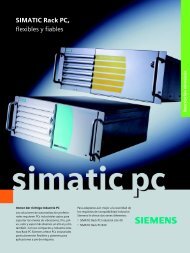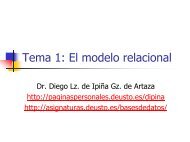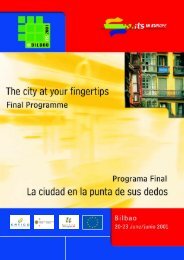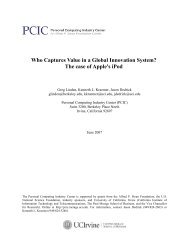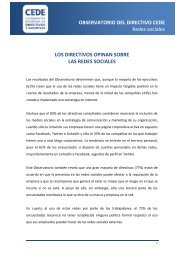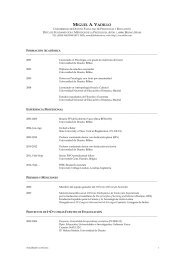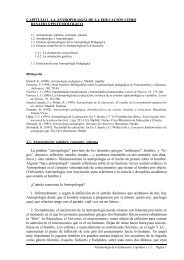Transparencias del curso - Universidad de Deusto
Transparencias del curso - Universidad de Deusto
Transparencias del curso - Universidad de Deusto
Create successful ePaper yourself
Turn your PDF publications into a flip-book with our unique Google optimized e-Paper software.
Web Semántica Práctica<br />
Dr. Diego Lz. <strong>de</strong> Ipiña Gz. <strong>de</strong> Artaza<br />
http://paginaspesonales.<strong>de</strong>usto.es/dipina<br />
http://www.morelab.<strong>de</strong>usto.es<br />
http://www.ctme.<strong>de</strong>usto.es<br />
Contents<br />
1. Web 2.0: una revolución en ciernes<br />
<br />
<br />
Tecnologías Web 2.0: AJAX, wikis, blogs, sindicación<br />
Aplicaciones Web 2.0: GoogleMaps, Flickr, <strong><strong>de</strong>l</strong>.icio.us, Digg<br />
2. SOA y Web Services<br />
<br />
<br />
El paradigma SOA<br />
Servicios Web Avanzados (WS-*)<br />
3. Practical Cases: <strong>Deusto</strong> WebLab y <strong>Deusto</strong> Sentient<br />
Graffiti<br />
4. Web Semántica y Servicios Web:<br />
<br />
<br />
<br />
Concepto<br />
Servicios Web Avanzados<br />
Servicios Web Semánticos<br />
5. Programming the Semantic Web with JENA<br />
2<br />
1
1. Web 2.0<br />
Dr. Diego Lz. <strong>de</strong> Ipiña Gz. <strong>de</strong> Artaza<br />
http://paginaspesonales.<strong>de</strong>usto.es/dipina<br />
http://www.morelab.<strong>de</strong>usto.es<br />
http://www.ctme.<strong>de</strong>usto.es<br />
Web 2.0<br />
4<br />
2
¿Qué es Web 2.0<br />
Una “palabreja” (buzzword) que hace referencia a:<br />
<br />
Todo aquello nuevo y popular en la web<br />
Web participativa tanto <strong>de</strong> humanos como <strong>de</strong> máquinas<br />
Cambio en la manera en que la gente ve la web:<br />
<br />
“Read/Write Web” y la “Web como una Plataforma”<br />
Acuñado por Tim O'Reilly y Dale Dougherty<br />
Observaron que varias aplicaciones web utilizan tecnologías<br />
existentes <strong>de</strong> una manera nueva e innovadora<br />
<br />
Basada en una industria más madura (economía web sana)<br />
5<br />
Revolución Web 2.0<br />
<br />
<br />
<br />
<br />
<br />
Repentina renovación <strong>de</strong> energía en la web<br />
Nuevas aplicaciones apareciendo cada día<br />
Gran<strong>de</strong>s empresas mostrando su talento<br />
Inversión en web start-ups <strong>de</strong> nuevo<br />
Pero:<br />
No comentamos los errores <strong><strong>de</strong>l</strong> 2000<br />
Temas <strong>de</strong> usabilidad/accesibilidad comprometidos<br />
Aplicaciones interesantes, pero no mo<strong><strong>de</strong>l</strong>o negocio<br />
6<br />
3
Web 2.0 como Plataforma<br />
<br />
<br />
<br />
La Web está pasando <strong>de</strong> ser un sistema <strong>de</strong> envío <strong>de</strong><br />
documentos a …<br />
Una plataforma <strong>de</strong> aplicaciones<br />
Simplifica la distribución<br />
Promociona el mo<strong><strong>de</strong>l</strong>o <strong>de</strong> subscripción en vez <strong>de</strong> la<br />
compra <strong>de</strong> una vez<br />
7<br />
Web 1.0 vs. Web 2.0<br />
Web 1.0<br />
Altavista<br />
Hotmail<br />
Ofoto<br />
Mp3.com<br />
Geocities<br />
MapQuest<br />
Encarta<br />
Slashdot<br />
Web 2.0<br />
Google<br />
Yahoo Mail<br />
Flickr<br />
iTunes<br />
Blogger<br />
Google Maps<br />
Wikipedia<br />
Digg<br />
8<br />
4
Requisitos para un Aplicación Web 2.0<br />
<br />
<br />
<br />
Datos abiertos<br />
Formatos <strong>de</strong> datos abiertos<br />
Habilidad para usar datos fuera <strong>de</strong> la aplicación<br />
Permite al usuario crearse sus propios datos<br />
Arquitectura <strong>de</strong> participación<br />
Provee un servicio no un producto<br />
Incentiva la participación<br />
Inteligencia colectiva<br />
Fácil reutilizar y mezclar<br />
Formar parte <strong>de</strong> una comunidad<br />
Buena experiencia <strong>de</strong> usuario<br />
Fácil <strong>de</strong> usar y atractiva<br />
Interfaz <strong>de</strong> usuario rica<br />
Funciona como una aplicación tradicional<br />
9<br />
Tecnologías Web 2.0 Claves<br />
<br />
<br />
<br />
<br />
Apertura <strong>de</strong> datos a través <strong>de</strong> APIs y Servicios Web<br />
RSS<br />
Ajax<br />
Estándares web (DOM, XHTML, CSS)<br />
10<br />
5
Tecnologías <strong>de</strong> Presentación Web 2.0<br />
<br />
<br />
<br />
<br />
<br />
<br />
Aplicaciones AJAX<br />
http://www.ajaxian.com/<br />
Desktop Widgets<br />
http://widgets.yahoo.com/<br />
Aplicaciones Flex<br />
http://www.adobe.com/products/flex/<br />
OpenLazlo<br />
http://www.openlaszlo.org/<br />
XUL<br />
http://www.mozilla.org/projects/xul/<br />
Smart Clients and Avalon<br />
http://msdn.microsoft.com/winfx/technologies/presentation/<strong>de</strong>fault.<br />
aspx<br />
11<br />
Aplicación Web 2.0<br />
<br />
Un portal Web 2.0 suele presentar las siguientes<br />
características:<br />
Rico mecanismo <strong>de</strong> interacción: Ajax, Lazslo<br />
CSS<br />
XHMTL valido o utilización <strong>de</strong> microformatos (añadir semántica en<br />
HTML)<br />
Sindicación y agregación <strong>de</strong> datos basada en RSS y Atom<br />
Publicación <strong>de</strong> Weblogs<br />
Mashups<br />
REST o XML WebServices APIs<br />
12<br />
6
Arquitectura Web 2.0<br />
13<br />
AJAX<br />
<br />
AJAX (Asynchronous Javascript and XML), técnica <strong>de</strong><br />
<strong>de</strong>sarrollo que genera aplicaciones web más interactivas<br />
combinando:<br />
XHTML y CSS para la presentación <strong>de</strong> información<br />
Document Object Mo<strong><strong>de</strong>l</strong> (DOM) para visualizar dinámicamente e<br />
interactuar con la información presentada<br />
XML, XSLT para intercambiar y manipular datos<br />
JSON y JSON-RPC pue<strong>de</strong>n ser alternativas a XML/XSLT<br />
XMLHttpRequest para recuperar datos asíncronamente<br />
Javascript como nexo <strong>de</strong> unión <strong>de</strong> todas estas tecnologías<br />
14<br />
7
¿Por qué AJAX<br />
<br />
<br />
<br />
Las aplicaciones web proliferan <strong>de</strong>bido a su simplicidad,<br />
pero:<br />
Ofrecen una menor interactividad y usabilidad en comparación<br />
con las aplicaciones <strong>de</strong>sktop.<br />
La interacción <strong><strong>de</strong>l</strong> usuario con una aplicación web se interrumpe<br />
cada vez que se necesita algo <strong><strong>de</strong>l</strong> servidor<br />
Varias tecnologías han sido diseñadas para resolver este<br />
problema:<br />
Java Applets, FLASH<br />
AJAX permite lo mismo pero sin plug-ins<br />
15<br />
Características AJAX<br />
<br />
<br />
<br />
<br />
<br />
Aplicaciones son más interactivas al estilo <strong>de</strong>sktop<br />
Look and feel similar a las aplicaciones <strong>de</strong> sobremesa sin plug-ins<br />
o características específicas <strong>de</strong> los navegadores<br />
Reduce tamaño <strong>de</strong> la información intercambiada<br />
Muchas micro-peticiones, flujo <strong>de</strong> datos global inferior<br />
Libera <strong>de</strong> procesamiento a la parte servidora<br />
Actualiza porciones <strong>de</strong> la página en vez <strong>de</strong> la página<br />
completa<br />
Necesario asegurar aplicación AJAX funciona en todo<br />
navegador<br />
16<br />
8
Arquitectura AJAX<br />
17<br />
Aplicaciones AJAX Famosas<br />
<br />
<br />
Empresas <strong>de</strong> referencia en la web <strong>de</strong>finen soluciones AJAX:<br />
Google<br />
Orkut (https://www.orkut.com/Login.aspx) es una comunidad virtual que<br />
conecta online a gente a través <strong>de</strong> una red <strong>de</strong> amigos.<br />
Gmail (www.gmail.com)<br />
Google Suggest (http://www.google.com/webhpcomplete=1&hl=en) <br />
sugiere valores <strong>de</strong> búsqueda a medida que escribes caracteres<br />
Google Maps (http://maps.google.com/)<br />
Yahoo!<br />
Flickr (http://www.flickr.com/) es una aplicación para gestionar y compartir<br />
fotos<br />
Oddpost (http://oddpost.com/learnmore)<br />
<br />
El equipo <strong>de</strong> Oddpost ha rediseñado Yahoo! Mail siguiendo la filosofía AJAX<br />
En <strong>de</strong>finitiva, AJAX es un buena solución técnica con gran<br />
aplicabilidad, <strong>de</strong>mostrada por aplicaciones reales complejas.<br />
18<br />
9
Problemas con AJAX<br />
<br />
<br />
<br />
<br />
Disponibilidad <strong><strong>de</strong>l</strong> objecto XMLHttpRequest<br />
Usabilidad<br />
Carga <strong><strong>de</strong>l</strong> Servidor<br />
Comportamiento Asíncrono<br />
19<br />
Ejemplo AJAX<br />
<br />
Conversor números romanos a árabes<br />
20<br />
10
Ejemplo AJAX<br />
<br />
En el HTML:<br />
<br />
Ejemplo AJAX<br />
<br />
En JavaScript:<br />
function callback() {<br />
if (req.readyState == 4) {<br />
if (req.status == 200) {<br />
// update the HTML DOM<br />
var message =<br />
req.responseXML.getElementsByTagName("message")[0];<br />
var responseElement =<br />
document.getElementById("romanNum");<br />
responseElement.value =<br />
message.childNo<strong>de</strong>s[0].no<strong>de</strong>Value;<br />
}<br />
}<br />
}<br />
23<br />
Frameworks AJAX<br />
<br />
<br />
JavaScript puras:<br />
http://prototype.conio.net/<br />
http://script.aculo.us/<br />
http://openrico.org/<strong>de</strong>mos.page<br />
Parte Servidora:<br />
http://www.getahead.ltd.uk/dwr<br />
http://atlas.asp.net/Default.aspxtabid=47<br />
24<br />
12
Wikis<br />
<br />
<br />
Un tipo <strong>de</strong> portal que permite a los usuarios editar, añadir,<br />
borrar su contenido <strong>de</strong> manera rápida y sencilla<br />
Herramienta efectiva <strong>de</strong> escritura colaborativa<br />
A través <strong><strong>de</strong>l</strong> browser y utilizando una sintaxis muy simple el<br />
usuario pue<strong>de</strong> escribir documentos<br />
MediaWiki es una buena herramienta<br />
25<br />
Weblogs<br />
<br />
<br />
<br />
<br />
Bitácoras web que recogen artículos periódicos en or<strong>de</strong>n<br />
cronológico inverso<br />
Se concentran en una temática particular:<br />
Comida<br />
Política<br />
Tecnología<br />
Dan oportunidad a que la gente comente en la bitácora<br />
Herramientas: Blogger, WordPress<br />
26<br />
13
Sindicación<br />
<br />
<br />
<br />
<br />
La sindicación web es una forma <strong>de</strong> sindicación don<strong>de</strong> un<br />
parte <strong>de</strong> un portal es hecho disponible para ser usado por<br />
otros<br />
Un portal facilita web feeds:<br />
Web feed = documento XML con elementos <strong>de</strong> contenido (título,<br />
<strong>de</strong>scripción) y enlaces a versiones largas <strong><strong>de</strong>l</strong> contenido<br />
Varios formatos:<br />
Rich Site Summary (RSS 0.91)<br />
RDF Site Summary (RSS 0.9, 1.0 and 1.1)<br />
Really Simple Syndication (RSS 2.0)<br />
Atom<br />
Utilizamos agregadores para subscribirnos a web o<br />
podcast feeds<br />
Promociona un mo<strong><strong>de</strong>l</strong>o “push” para la web<br />
27<br />
RSS: Formato <strong>de</strong> Sindicación<br />
<br />
<br />
Ejemplo <strong>de</strong> canal<br />
http://example.com/<br />
Ejemplo <strong>de</strong> fuente RSS<br />
es<br />
<br />
1 < 2<br />
http://example.com/1_less_than_2.html<br />
1 < 2, 3 < 4. En HTML, <b><br />
comienza una frase en negrita<br />
y pue<strong>de</strong>s comenzar un enlace con <a href=<br />
<br />
<br />
<br />
<br />
<br />
28<br />
14
Ingredientes Tecnológicos Web 2.0<br />
Web 2.0 permite ensamblar nuevas aplicaciones “mezclando”<br />
funcionalidad <strong>de</strong> otras aplicaciones Web 2.0:<br />
Esto es posible gracias a:<br />
Disponibilidad <strong>de</strong> APIs:<br />
Google Maps API, permite ligar información <strong>de</strong> otras fuentes sobre un mapa<br />
Otras APIs <strong>de</strong> eBay, Yahoo, Amazon<br />
RSS como una interfaz: es un potente mecanismo <strong>de</strong> comunicación <strong>de</strong><br />
cambios en portales y permite integrar datos <strong>de</strong> diversas fuentes<br />
Folksonomías: o anotación comunitaria permite a un portal crear una<br />
categorización <strong>de</strong> sus contenidos <strong>de</strong> acuerdo a la opinión <strong>de</strong> sus<br />
visitantes.<br />
Social networking: es la mejora <strong>de</strong> una aplicación cuando los usuarios<br />
<strong>de</strong>signan su relación con los usuarios <strong><strong>de</strong>l</strong> mismo portal o aplicación<br />
29<br />
Mash-ups<br />
<br />
<br />
Mash-up: una aplicación web que combina contenido <strong>de</strong> varias<br />
fuentes en una experiencia integrada<br />
http://www.programmableweb.com/matrix<br />
Hay muchos mash-ups basados alre<strong>de</strong>dor <strong>de</strong> GoogleMaps:<br />
http://googlemapsmania.blogspot.com/<br />
Algunos ejemplos:<br />
Tagzania (http://www.tagzania.com/)<br />
Maplandia.com News Center (http://www.maplandia.com/news/)<br />
Real-time location of Dublin commuter trains (http://dartmaps.mackers.com/)<br />
HousingMaps gets the locations of properties for sale or rent from Craigslist on<br />
the fly<br />
Cheap Gas (http://www.mywikimap.com/)<br />
Chicagocrime.org that taps into Google Maps to display where crimes occur in<br />
Chicago (http://www.chicagocrime.org/map/)<br />
30<br />
15
Aplicaciones Web 2.0 Famosas<br />
31<br />
Web 2.0: Resumen<br />
32<br />
16
Referencias Web 2.0<br />
Web 2.0<br />
Blog Dion Hinchcliffe<br />
http://web2.wsj2.com/<br />
Excelente presentación sobre Web 2.0<br />
http://www.squidoo.com/introtoweb20/<br />
Tim O’Reilly – “What Is Web 2.0, Design Patterns and Business<br />
Mo<strong><strong>de</strong>l</strong>s for the Next Generation of Software”<br />
http://www.oreillynet.com/lpt/a/6228<br />
33<br />
2. SOA y Web Services<br />
Dr. Diego Lz. <strong>de</strong> Ipiña Gz. <strong>de</strong> Artaza<br />
http://paginaspesonales.<strong>de</strong>usto.es/dipina<br />
http://www.morelab.<strong>de</strong>usto.es<br />
http://www.ctme.<strong>de</strong>usto.es<br />
17
Service Oriented Arquitecture (SOA)<br />
<br />
<br />
<br />
<br />
Perspectiva <strong>de</strong> arquitectura software que utiliza servicios<br />
para dar soporte a los requerimientos <strong>de</strong> los usuarios<br />
Diferentes nodos hacen disponibles servicios que los<br />
participantes pue<strong>de</strong>n acce<strong>de</strong>r<br />
SOA promociona servicios <strong>de</strong>sligados interoperables<br />
La interoperabilidad se garantiza a través <strong>de</strong> la <strong>de</strong>finición <strong>de</strong><br />
contratos (WSDL)<br />
No requiere uso <strong>de</strong> Servicios Web, aunque es lo normal<br />
Lenguajes <strong>de</strong> alto nivel como BPEL o la especificación<br />
WS-Coordination permiten orquestar servicios básicos en<br />
compuestos representando procesos <strong>de</strong> negocio<br />
35<br />
Service Oriented Arquitecture (SOA)<br />
<br />
<br />
<br />
SOA permite proveer funcionalidad <strong>de</strong> aplicaciones y su<br />
consumo como servicios<br />
Los servicios pue<strong>de</strong>n ser invocados, publicados y<br />
<strong>de</strong>scubiertos<br />
Son abstraídos <strong>de</strong> la implementación mediante una simple<br />
interfaz, basada en estándares.<br />
Conjunto <strong>de</strong>:<br />
políticas<br />
prácticas<br />
frameworks<br />
patrones <strong>de</strong> arquitectura<br />
36<br />
18
Antes <strong>de</strong> SOA<br />
Máquina<br />
A<br />
3<br />
IDL<br />
Máquina<br />
B<br />
RPC<br />
Registry<br />
4<br />
IDL<br />
proxy<br />
petición<br />
2<br />
NDR<br />
respuesta<br />
RPC (TCP)<br />
1<br />
IDL<br />
stub<br />
Registry<br />
inspección máquina<br />
B<br />
1<br />
2<br />
3<br />
4<br />
Protocolo <strong>de</strong> Comunicación<br />
Formato <strong>de</strong> Mensaje<br />
Descripción <strong><strong>de</strong>l</strong> lenguaje<br />
Mecanismo <strong>de</strong> Descubrimiento<br />
37<br />
Antes <strong>de</strong> SOA<br />
<br />
<br />
Sin estándares universales no hay interoperabilidad<br />
Múltiples tecnologías para hacer lo mismo<br />
No interoperables entre sí<br />
Ligados a una plataforma<br />
DCOM<br />
CORBA<br />
Java RMI<br />
RPC Protocol<br />
RPC<br />
IIOP<br />
IIOP or JRMP<br />
Message Format<br />
NDR<br />
CDR<br />
Java Ser. Format<br />
Description<br />
IDL<br />
OMG IDL<br />
Java<br />
Discovery<br />
Windows Registry<br />
Naming Service<br />
RMI Registry or JNDI<br />
38<br />
19
Motivación SOA<br />
<br />
<br />
<br />
Los usuarios no quieren cerrarse a una plataforma<br />
Es necesaria una arquitectura sin premisas e<br />
in<strong>de</strong>pendiente <strong>de</strong> …<br />
plataforma<br />
lenguaje<br />
objetos<br />
mecanismos <strong>de</strong> llamada<br />
Bienvenido a SOA (Service Oriented Arquitecture)<br />
39<br />
Visión SOA<br />
<br />
SOA ve el mundo <strong>de</strong> una forma distinta<br />
Servicios autónomos<br />
Fronteras explícitas, asumir heterogeneidad<br />
Plataformas dispares<br />
Integración basada en mensajes XML<br />
40<br />
20
SOA Reference Mo<strong><strong>de</strong>l</strong><br />
<br />
Preten<strong>de</strong> estandarizar el concepto <strong>de</strong> SOA<br />
En Marzo <strong><strong>de</strong>l</strong> 2006, el grupo OASIS liberó su primer borrador<br />
http://www.oasis-open.org/committees/tc_home.phpwg_abbrev=soarm<br />
41<br />
Conceptos Clave en SOA<br />
Servicio<br />
Coreografía<br />
Stateless<br />
Directorio<br />
Binding<br />
Término<br />
Service-Oriented<br />
Architecture<br />
Orquestación<br />
Definición<br />
Un paradigma para organizar y utilizar funcionalidad distribuida bajo el<br />
control <strong>de</strong> diferentes entida<strong>de</strong>s. Ofrece mecanismos para ofrecer, <strong>de</strong>scubrir,<br />
interactuar y usar las capacida<strong>de</strong>s disponibles.<br />
Mecanismo mediante el cuál las necesida<strong>de</strong>s <strong>de</strong> un consumidor son<br />
satisfechas con las capacida<strong>de</strong>s <strong>de</strong> un productor<br />
Mecanismo para la concatenación <strong>de</strong> servicios<br />
Define mecanismos para la cooperación entre nodos participantes en una<br />
arquitectura SOA<br />
No <strong>de</strong>pen<strong>de</strong> en ningún estado anterior. Los servicios reciben toda la<br />
información que necesitan en la petición.<br />
Repositorio que <strong>de</strong>scribe los servicios disponibles en un dominio.<br />
La relación entre un proveedor y un consumidor es dinámica, se establece<br />
en tiempo <strong>de</strong> ejecución.<br />
42<br />
21
Ventajas SOA<br />
<br />
<br />
<br />
SOA promociona la reutilización e interconexión <strong>de</strong><br />
soluciones IT existentes en vez <strong>de</strong> empezar <strong>de</strong>s<strong>de</strong> 0<br />
Se ajusta perfectamente a los cambios <strong>de</strong> mercado<br />
SOA es una evolución <strong>de</strong> enfoques anteriores<br />
El uso <strong>de</strong> SOA implica la importancia <strong>de</strong> <strong>de</strong>finir interfaces<br />
bien <strong>de</strong>finidas e interoperables<br />
Reduce los costes <strong>de</strong> integración y permite la evolución dinámica<br />
43<br />
Importancia SOA<br />
<br />
Según Gartner:<br />
“By 2008, SOA will be a prevailing software engineering practice,<br />
ending the 40-year domination of monolithic software architecture<br />
(0.7 probability)”<br />
44<br />
22
Problemas <strong>de</strong> SOA<br />
<br />
<br />
<br />
Gestión <strong>de</strong> los metadatos <strong>de</strong> servicios<br />
Niveles <strong>de</strong> seguridad apropiados, ya que se usan<br />
servicios externos<br />
WS-Security <strong>de</strong>finido para dar respuesta a esto<br />
SOA y WS-* está en evolución<br />
Pocos profesionales que dominan estas tecnologías<br />
45<br />
SOA y los Servicios Web<br />
<br />
<br />
Los Servicios-Web son la clave <strong>de</strong> SOA<br />
Re<strong>de</strong>finición <strong>de</strong> las tecnologías distribuidas basada en<br />
XML<br />
Comunicación vía protocolos <strong>de</strong> Internet<br />
HTTP, SMTP, FTP…<br />
SOAP como formato <strong>de</strong> mensaje<br />
WSDL como <strong>de</strong>finición <strong>de</strong> servicios<br />
UDDI como localizador <strong>de</strong> Servicios-Web<br />
46<br />
23
Servicios Web Básicos (WS-I)<br />
UDDI<br />
WSDL<br />
XSD<br />
SOAP<br />
XML 1.0 + Namespaces<br />
Registro <strong>de</strong> WS<br />
Descripción n <strong>de</strong> WS<br />
Sistema <strong>de</strong> tipos Portable<br />
Protocolo <strong>de</strong> mensajes<br />
Mensajes Serializados<br />
Protocolos<br />
Lenguajes <strong>de</strong> Descripción<br />
Mecanismos <strong>de</strong> Descubrimiento<br />
Ver ws-i.org<br />
para<br />
mas <strong>de</strong>talles<br />
47<br />
Servicios Web Protocolos<br />
Servicios publicados<br />
Descubrimiento<br />
mediante<br />
UDDI<br />
Servicio 1<br />
Servicio 1<br />
Servicio<br />
Publicación<br />
mediante<br />
UDDI<br />
Registro UDDI<br />
Aplicación<br />
Aplicación<br />
Cliente<br />
Cliente<br />
Descripción mediante WSDL<br />
XML XML<br />
Schema<br />
WSDL<br />
Servicio<br />
Servicio<br />
Web<br />
Web<br />
Invocación/Acceso mediante SOAP<br />
Transporte mediante HTTP / SMTP / WAP<br />
Mensaje<br />
SOAP<br />
48<br />
24
Los Servicios Básicos no son Suficiente<br />
<br />
<br />
Los WS básicos (XSD, SOAP, WSDL, UDDI) consiguen<br />
una comunicación básica<br />
Proporcionan intercambio básico <strong>de</strong> mensajes XML<br />
Interconexión <strong>de</strong> sistemas heterogéneos<br />
La compartición <strong>de</strong> esquemas permite mayores abstracciones<br />
Pero, la mayoría <strong>de</strong> las aplicaciones empresariales<br />
necesitan MÁS…<br />
49<br />
Mejoras Necesarias<br />
<br />
Los Sevicios-Web tienen muchas necesida<strong>de</strong>s comunes<br />
Mo<strong><strong>de</strong>l</strong>o <strong>de</strong> seguridad ‘orientado a mensajes’<br />
Mensajería estable y confiable<br />
Soporte <strong>de</strong> Transacciones (entre WS)<br />
Mecanismos <strong>de</strong> Direccionamiento y Ruteo<br />
Mensajería Asíncrona<br />
Metadatos para ‘Políticas’ <strong>de</strong> WS<br />
Soporte para datos binarios<br />
50<br />
25
¿Cómo introducir esas mejoras<br />
<br />
SOAP proporciona un marco <strong>de</strong> trabajo para gestionar aspectos<br />
nuevos<br />
Hea<strong>de</strong>r/Body permiten extensibilidad<br />
<br />
<br />
<br />
<br />
<br />
<br />
<br />
<br />
51<br />
WS-*<br />
<br />
<br />
WS-* (nuevas ESPECIFICACIONES WS) extien<strong>de</strong> SOAP<br />
con cabeceras estándar<br />
Hay implementaciones <strong>de</strong> diferentes fabricantes (IBM, Sun, MS,<br />
etc.)<br />
Especificaciones estándar <strong>de</strong>finidas en:<br />
http://www.oasis-open.org<br />
52<br />
26
27<br />
53<br />
WS-* Especificaciones<br />
<br />
Messaging<br />
<br />
WS-Addressing<br />
<br />
WS-Eventing<br />
<br />
MTOM (Attachments)<br />
<br />
Reliability<br />
<br />
WS-ReliableMessaging<br />
<br />
Security<br />
<br />
WS-Security<br />
<br />
WS-Trust<br />
<br />
WS-SecureConversation<br />
<br />
WS-Fe<strong>de</strong>ration<br />
<br />
Transactions<br />
<br />
WS-Coordination<br />
<br />
WS-AtomicTransaction<br />
<br />
WS-BusinessActivity<br />
<br />
BPEL<br />
<br />
Metadata<br />
<br />
WS-Policy<br />
<br />
WS-PolicyAssertions<br />
<br />
WS-PolicyAttachment<br />
<br />
WS-SecurityPolicy<br />
<br />
WS-Discovery<br />
<br />
WS-MetadataExchange<br />
54<br />
Arquitectura Futura WS-*<br />
Seguridad<br />
Mensajería<br />
confiable<br />
Transacciones<br />
Mensajería<br />
XML<br />
Metadatos<br />
Transportes<br />
Transportes<br />
Aplicaciones Conectadas<br />
Aplicaciones Conectadas
Algunas Especificaciones Avanzadas<br />
<br />
<br />
<br />
<br />
<br />
WS-Addressing<br />
Permite el paso <strong>de</strong> referencias a una implementación <strong>de</strong> un<br />
servicio web<br />
Conjunto <strong>de</strong> propieda<strong>de</strong>s<br />
MTOM (Message Transmission Optimization Mechanism)<br />
Método para el envío eficiente <strong>de</strong> datos binarios<br />
WS-Security<br />
Permite la autenticación entre peers<br />
Confi<strong>de</strong>ncialidad en los mensajes<br />
WS-ReliableExchange<br />
Garantiza el envío robusto <strong>de</strong> mensajes<br />
WS-Eventing<br />
Permite un mo<strong><strong>de</strong>l</strong>o <strong>de</strong> comunicación publish/subscribe en SOA<br />
55<br />
Enterprise Web 2.0<br />
<br />
<br />
<br />
Convergencia Web 2.0 y SOA<br />
Web 2.0 = Global SOA<br />
Web 2.0 interfaz para SOA<br />
SOA:<br />
Más centralizada, controlada<br />
Sin interfaz<br />
Web 2.0 requiere <strong>de</strong> SOA<br />
56<br />
28
References Web Services<br />
<br />
<br />
SOA<br />
The Next Big Thing: Service-Oriented Architecture (SOA) Takes a<br />
New Route<br />
http://java.sun.com/<strong>de</strong>veloper/technicalArticles/Interviews/routeone_q<br />
a.htmlfeed=JSC<br />
OASIS SOA Reference Mo<strong><strong>de</strong>l</strong><br />
<br />
http://www.oasis-open.org/committees/tc_home.phpwg_abbrev=soarm<br />
WS-* Specifications<br />
An Introduction to the Web Services Architecture and Its<br />
Specifications<br />
http://msdn.microsoft.com/webservices/webservices/building/wse/<strong>de</strong>fa<br />
ult.aspxpull=/library/en-us/dnwebsrv/html/introwsa.asp<br />
WS-BPEL Gui<strong>de</strong><br />
<br />
http://smartcomps.kgbinternet.com/confluence/pages/viewpage.action<br />
pageId=182<br />
57<br />
3. Practical Cases: <strong>Deusto</strong> WebLab<br />
y <strong>Deusto</strong> Sentient Graffiti<br />
Dr. Diego Lz. <strong>de</strong> Ipiña Gz. <strong>de</strong> Artaza<br />
http://paginaspesonales.<strong>de</strong>usto.es/dipina<br />
http://www.morelab.<strong>de</strong>usto.es<br />
http://www.ctme.<strong>de</strong>usto.es<br />
29
<strong>Deusto</strong> WebLab<br />
<br />
<br />
En la <strong>Universidad</strong> <strong>de</strong> <strong>Deusto</strong> tenemos nuestro propio<br />
WebLab<br />
Financiado por:<br />
Gobierno Vasco<br />
<strong>Universidad</strong> <strong>de</strong> <strong>Deusto</strong><br />
Lo estáan utilizando alumnos en prácticas <strong>de</strong> asignaturas<br />
3º <strong>de</strong> Ingeniería Técnica Industrial especialidad en Electrónica<br />
Industrial, 2º semestre <strong><strong>de</strong>l</strong> <strong>curso</strong> 2004-2005, con PLDs<br />
5º <strong>de</strong> Ingenier´ıa en Autom´atica y Electr´onica Industrial,<br />
1ºsemestre <strong><strong>de</strong>l</strong> <strong>curso</strong> 2005-2006, con FPGAs<br />
3º <strong>de</strong> Ingeniería Técnica Industrial especialidad en Electrónica<br />
Industrial, 2º semestre <strong><strong>de</strong>l</strong> <strong>curso</strong> 2005-2006, con PLDs<br />
59<br />
<strong>Deusto</strong> WebLab<br />
60<br />
30
<strong>Deusto</strong> WebLab<br />
61<br />
Mobility 2.0 = Mobile Web 2.0<br />
Mobility 2.0 = Mobile Web 2.0<br />
<br />
Web sites are becoming programmable<br />
PROBLEM: We enjoy Web 2.0 in <strong>de</strong>sktop but in mobile <strong>de</strong>vices<br />
Some relevant examples:<br />
Google’s Local for Mobiles (http://www.google.com/glm/)<br />
Yahoo! Go Mobile (Contacts, Email, Photos, Messenger)<br />
http://go.connect.yahoo.com/go/mobile<br />
Moblog clients (Mobile Blogger, KABLOG)<br />
62<br />
31
Mobile Mash-ups<br />
<br />
<br />
Mobile Mash-up: a web application adapted to mobile<br />
<strong>de</strong>vices combining content from several sources into an<br />
integrated experience<br />
Traditional mobile phone-based data usage is downstream<br />
Mobile Mash-ups can <strong>de</strong>finitely push the upstream usage<br />
Some cool mobile mash-ups:<br />
Mobile Gmaps displays Google Maps, Yahoo! Maps, Windows<br />
Live Local and Ask.com Maps and satellite imagery on Java ME<br />
<strong>de</strong>vices (http://www.mgmaps.com/)<br />
Shozu = basic blog XML-RPC services + photo upload<br />
(http://www.shozu.com/portal/)<br />
Socialight (http://socialight.com) places virtual "sticky" notes<br />
anywhere in the real world.<br />
A StickyShadow = media (text, picture) + access rights + location<br />
63<br />
Platforms to Develop Mobile Mash-ups<br />
<br />
<br />
Two main mo<strong><strong>de</strong>l</strong>s:<br />
Browsing apps, web apps which take into account limitations<br />
unique to mobility (e.g. small <strong>de</strong>vice)<br />
Client capable of hardly any processing<br />
XHTML (ASP.NET Mobile Web Controls & JSF)<br />
Smart Client apps: downloa<strong>de</strong>d and installed in the <strong>de</strong>vice<br />
Capable of some processing, storage and intermittent communication<br />
J2ME, Compact.NET, Python for Series 60, BREW uiOne, Flash Lite<br />
Other minor ones: hybrid, SIM, messaging and embbe<strong>de</strong>d apps<br />
Current problems of mobile space apps:<br />
Few mobile services are profitable (broadcast ones)<br />
No consensus, same application <strong>de</strong>veloped for several platforms<br />
64<br />
32
AJAX & Mobile Devices<br />
AJAX is a very important facet of Web 2.0<br />
Avoids start-stop cycles thanks to Ajax Engine<br />
The AJAX engine emits asynchronous calls to the server<br />
The user does not wait<br />
A combination of a number of existing technologies.<br />
Solves two problems:<br />
<br />
<br />
Superior UI experience<br />
Standarised form of data retrieval<br />
But NOT so much presence in mobile <strong>de</strong>vices !!!<br />
65<br />
AJAX & Mobile Devices<br />
<br />
Will AJAX replace J2ME, Compact.NET or XHTML as the<br />
platform to <strong>de</strong>velop Mobile Applications<br />
AJAX (Asynchronous JavaScript and XML) makes even more<br />
sense in the mobile space as it enables the creation of Web<br />
based services that are so fast they seem like local apps<br />
So far limited input and slow network connections prevented wi<strong>de</strong>r<br />
adoption<br />
Now, simply load the AJAX app in the mobile and use XML to<br />
exchange data with the server:<br />
Bandwidth constraint no problem any longer<br />
Transparently update the information on the mobile<br />
BUT WE NEED FLAT RATES AND ACCESS TO PHONE APIS!!!<br />
66<br />
33
AJAX support on Mobile Devices<br />
<br />
All the <strong>de</strong>vices that come with Opera Browser or Windows<br />
Mobile 5 support AJAX<br />
High range Nokia s60 a s90<br />
Nokia 770<br />
Small Ren<strong>de</strong>ring Technology paramount !!!<br />
67<br />
Hybrid approach: Opera Platform<br />
<br />
<br />
AJAX <strong>de</strong>velopment on mobile <strong>de</strong>vices is possible with the Opera<br />
Platform, co<strong>de</strong> named Freedom<br />
Based on well-known Web Technologies such as HTML, CSS and<br />
JavaScript http://www.opera.com/platform (homepage)<br />
http://my.opera.com/operaplatform/links/ (documentation & tools)<br />
Features:<br />
Enables integration between:<br />
Handheld <strong>de</strong>vices’ local applications<br />
Opera Browser environment<br />
Operator’s online content<br />
Allows operators to push their content and services on the handset<br />
Hybrid between Browsing and Smart Client apps<br />
68<br />
34
Opera Platform SDK<br />
<br />
The Opera Platform architecture consists of three<br />
parts:<br />
Application Player, an exten<strong>de</strong>d version of the<br />
Opera browser, provi<strong>de</strong>s web applications with<br />
access to native phone functionality such as<br />
messaging, calendar, battery and signal status.<br />
Application Framework, which supports interaction<br />
between installed web applications.<br />
It also offers pre<strong>de</strong>fined UI elements, such as menu<br />
systems and dialog boxes to ease application<br />
<strong>de</strong>velopment, according to Opera.<br />
Web applications created with open standard<br />
technologies such as HTML, CSS and JavaScript.<br />
Access the phone's functionality through the Opera<br />
Platform DOM interface<br />
Communicate with servers using XMLHttpRequest<br />
69<br />
Opera Mini: Customizing Web Ren<strong>de</strong>ring<br />
<br />
<br />
Opera Mini is a Java ME web browser for<br />
mobile <strong>de</strong>vices<br />
Versions for low and high memory phones<br />
Fetches content through a proxy that runs<br />
the layout engine of the Opera <strong>de</strong>sktop<br />
browser<br />
Proxy uses Small Ren<strong>de</strong>ring Technology to<br />
reformat webpages<br />
Content compressed 70-90% and <strong><strong>de</strong>l</strong>ivered in<br />
OBML<br />
70<br />
35
Google Maps Mashups & Where 2.0<br />
<br />
<br />
<br />
There are many originals mash-ups out there based on<br />
GoogleMaps:<br />
http://googlemapsmania.blogspot.com/<br />
Some examples:<br />
Maplandia.com News Center (http://www.maplandia.com/news/)<br />
Real-time location of Dublin commuter trains<br />
(http://dartmaps.mackers.com/)<br />
HousingMaps gets the locations of properties for sale or rent from<br />
Craigslist on the fly<br />
Cheap Gas (http://www.mywikimap.com/)<br />
Chicagocrime.org that taps into Google Maps to display where<br />
crimes occur in Chicago (http://www.chicagocrime.org/map/)<br />
Where 2.0 is a conference that gathers people on<br />
location-based web apps<br />
71<br />
An Interesting Mobile Mash-up Scenario<br />
<br />
“I was sitting in the back of a cab one Saturday evening. I was using<br />
Kmaps (http://kmaps.ulocate.com/) to pull up listings of the closest<br />
restaurants. I choose one based on user posted reviews, directed the<br />
driver using an attached Google Maps mash-up, and upon arrival,<br />
tagged the map with my precise location so my friend could meet me.<br />
My friend wanted to know what the restaurant was serving before he<br />
<strong>de</strong>ci<strong>de</strong>d to come so I snapped a picture of the menu, uploa<strong>de</strong>d a quick<br />
picture and note to my blog with my tagged location and was<br />
immediately called by a 3rd friend who had seen the blog post and<br />
wanted to come as well”<br />
http://marketspaceadvisory.typepad.com/marketspace_advisor/2006/02/a<br />
dventures_with.html<br />
72<br />
36
Ubiquitous Web & Geofolksonomies<br />
<br />
<br />
Ubiquitous Web (UW) = pervasive web infrastructure in<br />
which all physical objects are resources accessible by<br />
URIs, providing information and services that enrich users’<br />
experiences in their physical context as the web does in<br />
the cyberspace<br />
Apps dynamically adapt to the user’s needs, <strong>de</strong>vice capabilities<br />
and environmental conditions.<br />
Making UW reality:<br />
Social tagging is a very efficient way of categorizing resources on<br />
the web, e.g. <strong><strong>de</strong>l</strong>.icio.us<br />
GeoFolksonomies = social tagging of geographic locations, e.g.<br />
Tagzania, mobile version<br />
AwareFolksonomies = users may associate objects with<br />
contextual attributes and metadata<br />
If the contextual attributes are met the metadata is ma<strong>de</strong> available<br />
73<br />
<strong>Deusto</strong> Sentient Graffiti<br />
<br />
<br />
<br />
We want to make Ubiquitous Web reality through an<br />
Aware Folksonomy:<br />
Mixing social tags, location, profiles, preferences, Semantic Web<br />
Goal: enable the edition, discovery and navigation of<br />
virtual post-it notes placed in the <strong>Deusto</strong> campus<br />
A post-it note is an XML document with some contextual attributes<br />
(profile of creator, location, time interval, attributes (tags))<br />
An inference engine will in real-time match the mobile <strong>de</strong>vice<br />
owner’s context against the available post-it notes at his location<br />
Should work both indoors (RFID) and outdoors (GPS)<br />
Should enable transparent handoffs between Wi-Fi and GPRS<br />
Hardware requirements: Wi-Fi, GPRS/UMTS, GPS, RFID<br />
74<br />
37
Google Map Extension Hacks<br />
<br />
<br />
<br />
<br />
Web Map Service (WMS) produces a map from a URL<br />
map = portrayal of geographic information as a digital transparent image<br />
file (.GIF o .PNG)<br />
URL indicates what information is to be shown on the map:<br />
portion of the earth<br />
<strong>de</strong>sired coordinate reference system<br />
output image width and height<br />
Specification managed by Open Geospatial Consortium (OGC)<br />
http://portal.opengeospatial.org/files/artifact_id=5316<br />
Overlay Custom Maps over Google Maps<br />
http://blog.kylemulka.com/p=287<br />
http://john<strong>de</strong>ck.blogspot.com/<br />
Automatic Tile Cutter (retrieves .PNGs from Google Maps Tile Server)<br />
http://mapki.com/in<strong>de</strong>x.phptitle=Automatic_Tile_Cutter<br />
Geoco<strong>de</strong>rs: assigning geographic coordinates (e.g. latitu<strong>de</strong>-longitu<strong>de</strong>)<br />
to street addresses<br />
75<br />
Conclusion<br />
<br />
<br />
<br />
<br />
Arrival of Web 2.0 dynamic asynchronous interfaces to<br />
mobile <strong>de</strong>vices will make us forget WAP’s bad experience<br />
Mobile Mash-ups can foster up-stream data usage<br />
Mobile operator’s can significantly increase ARPU<br />
Mobile Mash-ups can be really helpful and are finally<br />
reality with available mature platforms<br />
Hybrid browsing/smart client platforms seem the future<br />
What about Mobile Context-Aware Mash-ups research<br />
opportunities<br />
76<br />
38
References<br />
Mobile web 2.0: AJAX for mobile <strong>de</strong>vices<br />
Ajit Jaokar Blog: http://opengar<strong>de</strong>nsblog.futuretext.com<br />
Russel Beattie Notebook<br />
http://www.russellbeattie.com/notebook/<br />
Mobility 2.0<br />
C. Enrique Ortiz' Mobility Weblog – http://www.cenriqueortiz.com/weblog/<br />
Annotate your own multimedia map<br />
http://www.engadget.com/2005/03/08/how-to-make-your-own-annotatedmultimedia-google-map/<br />
Simple Google Maps example in Python<br />
http://gpswan<strong>de</strong>rer.blogspot.com/2005_04_01_gpswan<strong>de</strong>rer_archive.html<br />
Python for Series 60<br />
http://www.forum.nokia.com/python<br />
XML APIs for creating mashups<br />
http://www.programmableweb.com<br />
W3C MWI & Mobile Web 2.0<br />
http://blog.webservices.or.kr/hollobit/presentation/ngweb2006-hollobit.pdf<br />
77<br />
4. – Web Semántica<br />
Dr. Diego Lz. <strong>de</strong> Ipiña Gz. <strong>de</strong> Artaza<br />
http://paginaspesonales.<strong>de</strong>usto.es/dipina<br />
http://www.morelab.<strong>de</strong>usto.es<br />
http://www.ctme.<strong>de</strong>usto.es<br />
39
Web Semántica<br />
<br />
<br />
Problema <strong>de</strong> la Web Actual:<br />
El significado <strong>de</strong> la web no es accesible a máquinas<br />
Web Semántica crea un medio universal <strong>de</strong><br />
intercambio <strong>de</strong> información, aportando semántica a los<br />
documentos en la web<br />
Aña<strong>de</strong> significado comprensible por or<strong>de</strong>nadores a la Web<br />
Usa técnicas inteligentes que explotan esa semántica<br />
Li<strong>de</strong>rada por Tim Berners-Lee <strong><strong>de</strong>l</strong> W3C<br />
79<br />
Web vs. Web Semántica<br />
<br />
<br />
La Web permite acce<strong>de</strong>r a todo tipo <strong>de</strong> información<br />
fácilmente<br />
Los motores <strong>de</strong> búsqueda nos ayudan a encontrar información<br />
Pero, los resultados <strong>de</strong>vueltos no son siempre correctos<br />
Web Actual:<br />
Colección <strong>de</strong> documentos ligados por hipervínculos<br />
El texto <strong>de</strong> un enlace es una palabra clave que hace referencia a<br />
otros documentos<br />
Útil para <strong>de</strong>scribir, con un énfasis en presentación visual, bloques<br />
<strong>de</strong> texto, imágenes y formularios<br />
Pero, una máquina no pue<strong>de</strong> extraer semántica <strong>de</strong> listado <strong>de</strong><br />
productos en una página web<br />
80<br />
40
Web vs. Web Semántica<br />
<br />
<br />
La Web Semántica preten<strong>de</strong> crear un medio universal<br />
para intercambiar información y relacionar conceptos<br />
Web Semántica:<br />
Conjunto <strong>de</strong> conceptos ligados a otros conceptos<br />
<br />
RDF y OWL permiten indicar cómo un concepto se relaciona con otro<br />
Aña<strong>de</strong>n significado al contenido, facilitando el uso autónomo <strong>de</strong> la web<br />
por or<strong>de</strong>nadores<br />
81<br />
Semantic Web Stack<br />
<br />
La Web Semántica está compuesta <strong>de</strong>:<br />
XML, sintaxis para documentos estructurados<br />
XML Schema, restringe la estructura <strong>de</strong> documentos XML<br />
RDF es un mo<strong><strong>de</strong>l</strong>o <strong>de</strong> datos que hace referencia a objetos y sus<br />
relaciones<br />
RDF Schema, vocabulario para <strong>de</strong>finir propieda<strong>de</strong>s y clases <strong>de</strong><br />
re<strong>curso</strong>s RDF<br />
OWL, aña<strong>de</strong> más vocabulario que RDFS, relaciones entre clases,<br />
cardinalidad, igualdad …<br />
82<br />
41
Propósito Web Semántica<br />
<br />
<br />
Mejorar la usabilidad y utilidad <strong>de</strong> la Web y sus re<strong>curso</strong>s<br />
interconectados, mediante:<br />
Anotación semántica documentos mejorados con metadatos<br />
semánticos leíbles por máquinas o metadatos representando<br />
hechos sobre cualquier concepto (lugar, persona, etc.)<br />
Ontologías vocabularios <strong>de</strong> metadatos comunes y mapas<br />
entre ellos que guían marcado <strong>de</strong> documentos para que los<br />
agentes puedan utilizar la semántica suministrada<br />
Autor <strong>de</strong> la página o autor <strong><strong>de</strong>l</strong> libro<br />
Agentes realizan tareas para usuarios utilizando estos<br />
metadatos (shopbot)<br />
Infrastructura Servicios Web que suministren información a<br />
agentes (Trust Service – informa calidad información)<br />
Los principales facilitadores <strong>de</strong> la Web Semántica son<br />
URIs, XML, XML NameSpaces y RDF<br />
83<br />
Resource Description Framework (RDF)<br />
<br />
Mo<strong><strong>de</strong>l</strong>o basado en la <strong>de</strong>finición <strong>de</strong> sentencias acerca <strong>de</strong><br />
re<strong>curso</strong>s en formato:<br />
Sujeto-predicado-objeto RDF Triple<br />
Sujeto: re<strong>curso</strong> <strong>de</strong>scrito<br />
Predicado: relación entre sujeto y objeto<br />
Objeto: el valor asociado al sujeto<br />
84<br />
42
Resource Description Framework (RDF)<br />
<br />
<br />
Mo<strong><strong>de</strong>l</strong>o para <strong>de</strong>scribir pseudo-grafos dirigidos<br />
etiquetados:<br />
Dirigido cada arco tiene una dirección<br />
Etiquetado cada arco tiene una etiqueta<br />
Pseudo-grafo pue<strong>de</strong> haber más <strong>de</strong> un arco entre nodos<br />
Un mo<strong><strong>de</strong>l</strong>o RDF es una colección no or<strong>de</strong>nada <strong>de</strong><br />
sentencias o ternas, con:<br />
Sujeto (nodo)<br />
Predicado (arco)<br />
Objeto (nodo)<br />
85<br />
Resource Description Framework (RDF)<br />
<br />
<br />
<br />
<br />
Un grafo RDF crea una web <strong>de</strong> conceptos<br />
Realiza aserciones sobre relaciones lógicas entre entida<strong>de</strong>s<br />
Información en RDF pue<strong>de</strong> ligarse con grafos en otros<br />
lugares<br />
Mediante software se pue<strong>de</strong>n realizar inferencias<br />
<br />
Lenguajes <strong>de</strong> consulta sobre triple stores como SPARQL<br />
Mediante RDF hacemos que la información sea<br />
procesable por máquinas<br />
Agentes software pue<strong>de</strong>n guardar, intercambiar y utilizar<br />
metadatos sobre re<strong>curso</strong>s en la web<br />
Ontología jerarquía <strong>de</strong> términos a utilizar en<br />
etiquetado <strong>de</strong> re<strong>curso</strong>s<br />
86<br />
43
Conceptos Fundamentales RDF<br />
<br />
<br />
<br />
URIs mecanismo utilizado por RDF para i<strong>de</strong>ntificar<br />
unívocamente conceptos<br />
Literals objetos con contenido real en vez <strong>de</strong> URIs<br />
this line --- (was written on) --><br />
“20060603”[date]<br />
Reification uso <strong>de</strong> sentencias como sujeto <strong>de</strong> otras<br />
sentencias<br />
this news ---(has category)---> "semantic web“<br />
[this news ---(has category)---> "semantic web"] --<br />
-(ad<strong>de</strong>d by)---> stefano<br />
87<br />
Formatos RDF<br />
<br />
<br />
El mecanismo <strong>de</strong> serialización oficial <strong>de</strong> RDF es RDF/XML<br />
Tipo MIME es application/rdf+xml<br />
No es muy leíble<br />
Ej. Expresión en RDF <strong>de</strong> “Artículo en Wikipedia sobre Maradona”<br />
<br />
<br />
Diego Armando Maradona<br />
Wikipedia<br />
<br />
<br />
88<br />
44
Formatos RDF<br />
<br />
<br />
<br />
N3 es una notación que permite <strong>de</strong>finir ternas o relaciones<br />
“sujeto-predicado(verbo)-objeto”, <strong>de</strong> una manera más<br />
concisa<br />
Ej1:<br />
<br />
“Diego<br />
Armando Maradona" .<br />
Ej2:<br />
@prefix wcj: http://example.org/wcjava/uri/ .<br />
wcj:programmers wcj:enjoy wcj:java .<br />
89<br />
RDFS<br />
<br />
<br />
Extensión semántica <strong>de</strong> RDF<br />
Conjunto se <strong>de</strong> sentencias que <strong>de</strong>finen clases y propieda<strong>de</strong>s<br />
Sirve para <strong>de</strong>cir cosas como:<br />
Esta URI <strong>de</strong>bería ser consi<strong>de</strong>rada como una clase (rdfs:Class)<br />
o propiedad (rdfs:Property)<br />
Indicar si una etiqueta (rfds:label) o comentario<br />
(rdfs:comment) es leible por humanos<br />
Esta URL está <strong>de</strong>finida por (rfds:DefinedBy)<br />
Esta clase es subclase <strong>de</strong> (rdfs:subClassOf)<br />
Esta propiedad es subpropiedad <strong>de</strong> (rfds:subPropertyOf)<br />
Esta propiedad conecta esta clase <strong>de</strong> sujetos (rdfs:domain) con<br />
esta clase <strong>de</strong> objetos (rdfs:range)<br />
90<br />
45
OWL<br />
<br />
<br />
<br />
Acrónimo <strong>de</strong> Web Ontology Language, <strong>de</strong>rivado <strong>de</strong><br />
DAML+OIL<br />
Extensión <strong>de</strong> vocabulario a RDF aña<strong>de</strong> más metadatos<br />
a los nodos, clases y propieda<strong>de</strong>s para razonar sobre<br />
ellas<br />
OWL es a RDF lo que XSL es a XML<br />
Algunos ejemplos:<br />
Esta propiedad es transitiva (owl:TransitiveProperty)<br />
Esta propiedad es simétrica (owl:SymmetricProperty)<br />
Esta propiedad es inversa a esta otra (owl:InverseOf)<br />
Equivalente a (owl:equivalentProperty)<br />
Lo mismo que (owl:sameAs)<br />
Esta propiedad pue<strong>de</strong> aparecer sólo una vez<br />
(owl:cardinality)<br />
91<br />
Ejemplo OWL<br />
<br />
<br />
<br />
Supongamos el siguiente mo<strong><strong>de</strong>l</strong>o RDF:<br />
-(is author of)-><br />
http://www.betaversion.org/~stefano/linotype/<br />
-(is author of)-><br />
http://www.apache.org/~stefano/agora/<br />
-(is author of)-><br />
<br />
Aunque pertenecen al mismo autor, no están relacionadas entre ellas, con la ayuda <strong>de</strong><br />
OWL po<strong>de</strong>mos mapear estas URIs<br />
-(owl:sameAs<br />
owl:sameAs)-><br />
<br />
-(owl:sameAs<br />
owl:sameAs)-><br />
<br />
Si mezclamos ambos mo<strong><strong>de</strong>l</strong>os y ejecutamos un razonador podríamos respon<strong>de</strong>r a<br />
“dime todo lo que ha escrito “http://www.betaversion.org/~stefano”:<br />
http://www.betaversion.org/~stefano/> -(is author of)-><br />
http://www.apache.org/~stefano/agora/<br />
-(is author of)-><br />
<br />
92<br />
46
Lógica e Inferencia<br />
<br />
<br />
<br />
La lógica es la disciplina que estudia los principios <strong>de</strong><br />
razonamiento<br />
Los razonadores automáticos <strong>de</strong>ducen conclusiones a<br />
partir <strong><strong>de</strong>l</strong> conocimiento<br />
Aplicado a ontologías, pue<strong>de</strong>:<br />
Descubrir conocimiento ontológico implícito<br />
Descubrir relaciones e inconsistencias inesperadas<br />
93<br />
Críticas a la Web Semántica<br />
<br />
<br />
<br />
Para funcionar requiere hacer referencia a un vocabulario<br />
gigante y centralizado<br />
Debido a reification, las relaciones entre conceptos<br />
pue<strong>de</strong>n ser tan extensas que se incrementa la<br />
computabilidad<br />
Aconsejable utilizar OWL Lite (NO DL, Full) para no<br />
imponer <strong>de</strong>masiados requerimientos computacionales<br />
94<br />
47
Herramientas Web Semántica<br />
<br />
<br />
<br />
Jena para Java y CWM para Python<br />
Permiten transformar entre sintaxis N3 y RDF/XML<br />
Realizan inferencias<br />
95<br />
Referencias Web Semántica<br />
<br />
<br />
RDF:<br />
http://www.javaworld.com/javaworld/jw-12-2005/jw-1205-<br />
wicked_p.html<br />
OWL:<br />
A No-Nonsense Gui<strong>de</strong> to Semantic Web Specs for XML People<br />
<br />
http://www.betaversion.org/~stefano/linotype/news/57/<br />
96<br />
48
5. Programming Semantic Web with<br />
JENA<br />
Dr. Diego Lz. <strong>de</strong> Ipiña Gz. <strong>de</strong> Artaza<br />
http://paginaspesonales.<strong>de</strong>usto.es/dipina<br />
http://www.morelab.<strong>de</strong>usto.es<br />
http://www.ctme.<strong>de</strong>usto.es<br />
Jena: a Framework for Semantic Web<br />
<br />
<br />
Jena Semantic Web Framework<br />
http://jena.sourceforge.net/<br />
Enables among other things:<br />
Create and populate RDF mo<strong><strong>de</strong>l</strong>s<br />
Persist mo<strong><strong>de</strong>l</strong>s to a database<br />
Query mo<strong><strong>de</strong>l</strong>s programmatically with RDQL y SPARQL<br />
Reasoning over ontologies<br />
Currently in versión 2.4<br />
Download from: http://jena.sourceforge.net/downloads.html<br />
98<br />
49
Create a RDF Mo<strong><strong>de</strong>l</strong><br />
<br />
<br />
<br />
The Mo<strong><strong>de</strong>l</strong>Factory class enables the creation of<br />
mo<strong><strong>de</strong>l</strong>s:<br />
Mo<strong><strong>de</strong>l</strong>Factory.createDefaultMo<strong><strong>de</strong>l</strong>(), allows the creation<br />
of an in-memory mo<strong><strong>de</strong>l</strong><br />
Returns a Mo<strong><strong>de</strong>l</strong> instance over which you can create Resources<br />
Mo<strong><strong>de</strong>l</strong>.createProperty() allow relationship creation<br />
To add statements for a mo<strong><strong>de</strong>l</strong> use: Resource.addProperty()<br />
or Mo<strong><strong>de</strong>l</strong>.createStatement() and Mo<strong><strong>de</strong>l</strong>.add()<br />
In Jena a statement is composed of:<br />
A subject in the form of a Resource<br />
A predicate represented by a Property class<br />
An object, either a Literal or Resource<br />
Resource, Property and Literal inherit from<br />
RDFNo<strong>de</strong><br />
99<br />
Create a RDF Mo<strong><strong>de</strong>l</strong> representing a Family<br />
// URI <strong>de</strong>clarations<br />
String familyUri = "http://family/";<br />
String relationshipUri = "http://purl.org/vocab/relationship/";<br />
// Create an empty Mo<strong><strong>de</strong>l</strong><br />
Mo<strong><strong>de</strong>l</strong> mo<strong><strong>de</strong>l</strong> = Mo<strong><strong>de</strong>l</strong>Factory.createDefaultMo<strong><strong>de</strong>l</strong>();<br />
// Create a Resource for each family member, i<strong>de</strong>ntified by their URI<br />
Resource adam = mo<strong><strong>de</strong>l</strong>.createResource(familyUri+"adam");<br />
");<br />
Resource beth = mo<strong><strong>de</strong>l</strong>.createResource(familyUri+"beth");<br />
Resource chuck = mo<strong><strong>de</strong>l</strong>.createResource(familyUri+"chuck");<br />
Resource dotty = mo<strong><strong>de</strong>l</strong>.createResource(familyUri+"dotty");<br />
// and so on for other family members<br />
// Create properties for the different types of relationship to represent<br />
Property childOf = mo<strong><strong>de</strong>l</strong>.createProperty(relationshipUri,"childOf");<br />
");<br />
Property parentOf = mo<strong><strong>de</strong>l</strong>.createProperty(relationshipUri,"parentOf");<br />
Property siblingOf = mo<strong><strong>de</strong>l</strong>.createProperty(relationshipUri,"siblingOf");<br />
Property spouseOf = mo<strong><strong>de</strong>l</strong>.createProperty(relationshipUri,"spouseOf");<br />
// Add properties to adam <strong>de</strong>scribing relationships to other family members<br />
adam.addProperty(siblingOf,beth);<br />
adam.addProperty(spouseOf,dotty);<br />
adam.addProperty(parentOf,edward);<br />
// Can also create statements directly . . .<br />
Statement statement = mo<strong><strong>de</strong>l</strong>.createStatement(adam,parentOf,fran);<br />
// but remember to add the created statement to the mo<strong><strong>de</strong>l</strong><br />
mo<strong><strong>de</strong>l</strong>.add(statement);<br />
100<br />
50
Interrogating an RDF Mo<strong><strong>de</strong>l</strong><br />
<br />
<br />
By means of listXXX() method in Mo<strong><strong>de</strong>l</strong> and<br />
Resource interfaces<br />
It returns specializations of java.util.Iterator<br />
El método más genérico es<br />
Mo<strong><strong>de</strong>l</strong>.listStatements(Resource s, Property p,<br />
RDFNo<strong>de</strong> o)<br />
Examples:<br />
ResIterator parents =<br />
mo<strong><strong>de</strong>l</strong>.listSubjectsWithProperty(parentOf);<br />
Resource person = parents.nextResource();<br />
No<strong>de</strong>Iterator moreParents =<br />
mo<strong><strong>de</strong>l</strong>.listObjectsOfProperty(childOf);<br />
StmtIterator moreSiblings =<br />
edward.listProperties(siblingOf);<br />
mo<strong><strong>de</strong>l</strong>.listStatements(adam,null,null);<br />
101<br />
Importing and Persisting Mo<strong><strong>de</strong>l</strong>s<br />
<br />
<br />
<br />
<br />
So far we have worked with in-memory mo<strong><strong>de</strong>l</strong>s<br />
Necessary to persist and retrieve mo<strong><strong>de</strong>l</strong>s<br />
Easiest solution:<br />
Mo<strong><strong>de</strong>l</strong>.read()<br />
Mo<strong><strong>de</strong>l</strong>.write()<br />
More sophisticated over RDBMS:<br />
MySQL<br />
Example: ImportWordnet.java<br />
Imports the following RDF mo<strong><strong>de</strong>l</strong>s into a single Jena mo<strong><strong>de</strong>l</strong>:<br />
<br />
<br />
<br />
WordNet-nouns<br />
WordNet-glossary<br />
WordNet-hyponyms<br />
102<br />
51
RDF Data Query Language (RDQL)<br />
<br />
<br />
<br />
RDQL is a query language for RDF<br />
Allows complex queries to be expressed concisely<br />
A query engine performing the hard work of accessing the data mo<strong><strong>de</strong>l</strong><br />
Example:<br />
SELECT <strong>de</strong>finition<br />
WHERE<br />
(concept, , "domestic dog"),<br />
(concept, , <strong>de</strong>finition)<br />
USING<br />
wn FOR <br />
Another example:<br />
SELECT<br />
wordform, <strong>de</strong>finition<br />
WHERE<br />
(firstconcept, , "panther"),<br />
(secondconcept, , "tiger"),<br />
(firstconcept, , hypernym),<br />
(secondconcept, , hypernym),<br />
(hypernym, , wordform),<br />
(hypernym, , <strong>de</strong>finition)<br />
USING<br />
wn FOR <br />
103<br />
Using RDQL<br />
<br />
<br />
<br />
<br />
<br />
Need to import com.hp.hpl.jena.rdql<br />
To create a query instantiate Query and pass as a String the query<br />
Create QueryEngine and invoke QueryEngine.exec(Query)<br />
Variables can be bound to values through a ResultBinding object<br />
Example:<br />
// Create a new query passing a String containing the RDQL to execute, containing<br />
variables x and y<br />
Query query = new Query(queryString);<br />
// Set the mo<strong><strong>de</strong>l</strong> to run the query against<br />
query.setSource(mo<strong><strong>de</strong>l</strong>);<br />
// A ResultBinding specifies mappings between query variables and values<br />
ResultBindingImpl initialBinding = new ResultBindingImpl() ;<br />
// Bind the query's first variable to a resource<br />
Resource someResource = getSomeResource();<br />
initialBinding.add("x", someResource);<br />
// Bind the query's second variable to a literal value<br />
RDFNo<strong>de</strong> foo = mo<strong><strong>de</strong>l</strong>.createLiteral("bar");<br />
initialBinding.add("y", foo);<br />
// Use the query to create a query engine<br />
QueryEngine qe = new QueryEngine(query);<br />
// Use the query engine to execute the query<br />
QueryResults results = qe.exec();<br />
104<br />
52
Operations on Mo<strong><strong>de</strong>l</strong>s<br />
<br />
<br />
The common set operations:<br />
Union (.union(Mo<strong><strong>de</strong>l</strong>)) , intersection (.intersection(Mo<strong><strong>de</strong>l</strong>)) and difference<br />
(.difference(Mo<strong><strong>de</strong>l</strong>))<br />
Example: union<br />
// read the RDF/XML files<br />
mo<strong><strong>de</strong>l</strong>1.read(new InputStreamRea<strong>de</strong>r(in1), "");<br />
+<br />
mo<strong><strong>de</strong>l</strong>2.read(new InputStreamRea<strong>de</strong>r(in2), "");<br />
// merge the Mo<strong><strong>de</strong>l</strong>s<br />
Mo<strong><strong>de</strong>l</strong> mo<strong><strong>de</strong>l</strong> = mo<strong><strong>de</strong>l</strong>1.union(mo<strong><strong>de</strong>l</strong>2);<br />
// print the Mo<strong><strong>de</strong>l</strong> as RDF/XML<br />
mo<strong><strong>de</strong>l</strong>.write(system.out, "RDF/XML-ABBREV");<br />
+ =<br />
105<br />
Containers in RDF<br />
<br />
<br />
RDF <strong>de</strong>fines a special kind of resources to represent<br />
collections of things:<br />
A BAG is an unor<strong>de</strong>red collection<br />
An ALT, unor<strong>de</strong>red collection representing alternatives<br />
A SEQ is an or<strong>de</strong>red collection<br />
A container is represented by a resource with an rdf:type<br />
property whose value should be: rdf:Bag, rdf:Alt or rdf:Seq<br />
The ordinal properties are <strong>de</strong>noted by rdf:_N<br />
106<br />
53
SPARQL Protocol And RDF Query Language<br />
(SPARQL)<br />
<br />
<br />
Builds on previously existing query languages such as<br />
rdfDB, RDQL, SeRQL<br />
In our experimentation with SPARQL 3 RDF graphs will be<br />
used, corresponding to blogger.rdf:<br />
FOAF graphs <strong>de</strong>scribing contributors<br />
RSS 1.0 contributor feeds<br />
Bloggers graph<br />
107<br />
Syntax SPARQL<br />
<br />
<br />
SPARQL query to find the URL of a contributor’s blog (david.rq):<br />
PREFIX foaf: <br />
SELECT url<br />
FROM <br />
WHERE {<br />
contributor foaf:name “Dave Beckett" .<br />
contributor foaf:weblog url .<br />
}<br />
PREFIX indicates prefix for FOAF namespace<br />
SELECT indicates what the query should return<br />
FROM optional clause indicating the URI of the dataset to use<br />
WHERE triple patterns expressed in Turtle syntax (graph pattern)<br />
Test queries from command line with java jena.sparql<br />
java jena.sparql --query david.rq<br />
FROM clause can be omitted and specified by --data URL<br />
108<br />
54
Using SPARQL with JENA<br />
<br />
<br />
<br />
<br />
<br />
SPARQL is supported in JENA via ARQ module<br />
It also un<strong>de</strong>rstands RDQL queries<br />
Need to import package: com.hp.hpl.jena.query<br />
QueryFactory.create() returns a Query object from a file or<br />
String<br />
QueryExecutionFactory.create(query, mo<strong><strong>de</strong>l</strong>) returns a<br />
QueryExecution object<br />
QueryExecution supports varios methods:<br />
execSelect() returns a ResultSet<br />
Apart from SELECT, you can apply the following types of queries:<br />
<br />
ASK, DESCRIBE, CONSTRUCT<br />
109<br />
Executing a Simple Query with JENA<br />
// Open the bloggers RDF graph from the filesystem<br />
InputStream in = new FileInputStream(new File("bloggers.rdf"));<br />
// Create an empty in-memory mo<strong><strong>de</strong>l</strong> and populate it from the graph<br />
Mo<strong><strong>de</strong>l</strong> mo<strong><strong>de</strong>l</strong> = Mo<strong><strong>de</strong>l</strong>Factory.createMemMo<strong><strong>de</strong>l</strong>Maker().createMo<strong><strong>de</strong>l</strong>();<br />
mo<strong><strong>de</strong>l</strong>.read(in,null); // null base URI, since mo<strong><strong>de</strong>l</strong> URIs are absolute<br />
in.close();<br />
// Create a new query<br />
String queryString =<br />
"PREFIX foaf: " +<br />
"SELECT url " +<br />
"WHERE {" +<br />
" contributor foaf:name \"Jon Foobar\" . " +<br />
" contributor foaf:weblog url . " +<br />
" }";<br />
Query query = QueryFactory.create(queryString);<br />
// Execute the query and obtain results<br />
QueryExecution qe = QueryExecutionFactory.create(query, mo<strong><strong>de</strong>l</strong>);<br />
ResultSet results = qe.execSelect();<br />
// Output query results<br />
ResultSetFormatter.out(System.out, results, query);<br />
// Important - free up resources used running the query<br />
qe.close();<br />
110<br />
55
Refining SPARQL Queries<br />
<br />
<br />
DISTINCT used with SELECT<br />
SELECT DISTINCT<br />
Used with SELECT clause:<br />
LIMIT n shows upto n results<br />
OFFSET n ignores first n results<br />
ORDER BY var sorts results by normal or<strong>de</strong>ring<br />
<br />
ASC(var) and DESC(var)<br />
111<br />
More complex queries<br />
<br />
<br />
<br />
RDF is often used to represent semi-structured data. This means that two no<strong>de</strong>s of the<br />
same type in a mo<strong><strong>de</strong>l</strong> may have different sets of properties.<br />
Optional matches<br />
PREFIX foaf: <br />
SELECT name <strong>de</strong>piction<br />
WHERE {<br />
person foaf:name name .<br />
OPTIONAL {<br />
person foaf:<strong>de</strong>piction <strong>de</strong>piction .<br />
} .<br />
}<br />
Alternative matches:<br />
PREFIX foaf: <br />
PREFIX rdf: <br />
SELECT name mbox<br />
WHERE {<br />
person foaf:name name .<br />
{<br />
{ person foaf:mbox mbox } UNION { person foaf:mbox_sha1sum mbox<br />
}<br />
}<br />
}<br />
112<br />
56
More complex queries<br />
<br />
Using filters<br />
PREFIX rss:<br />
PREFIX xsd:<br />
PREFIX dc:<br />
<br />
<br />
<br />
SELECT item_title pub_date<br />
WHERE {<br />
item rss:title item_title .<br />
item dc:date pub_date .<br />
FILTER xsd:dateTime(pub_date) >= "2005-04-<br />
01T00:00:00Z"^^xsd:dateTime &&<br />
xsd:dateTime(pub_date) < "2005-05-<br />
01T00:00:00Z"^^xsd:dateTime<br />
}<br />
113<br />
Working with Multiple Graphs<br />
<br />
<br />
<br />
<br />
The mo<strong><strong>de</strong>l</strong> after the FROM clause is the background graph<br />
Several graphs can be specified after the FROM NAMED clause<br />
Named graphs are used within a SPARQL query with the GRAPH keyword<br />
Example: find people found in two named FOAF graphs<br />
PREFIX foaf: <br />
PREFIX rdf: <br />
SELECT name<br />
FROM NAMED <br />
FROM NAMED <br />
WHERE {<br />
GRAPH {<br />
x rdf:type foaf:Person .<br />
x foaf:name name .<br />
} .<br />
GRAPH {<br />
y rdf:type foaf:Person .<br />
y foaf:name name .<br />
} .<br />
}<br />
114<br />
57
Working with Multiple Graphs<br />
<br />
Example: <strong>de</strong>termining which graph <strong>de</strong>scribes different<br />
people<br />
PREFIX foaf: <br />
PREFIX rdf: <br />
SELECT name graph_uri<br />
FROM NAMED <br />
FROM NAMED <br />
WHERE {<br />
GRAPH graph_uri {<br />
x rdf:type foaf:Person .<br />
x foaf:name name .<br />
}<br />
}<br />
115<br />
Combining Background Data and Named<br />
Graphs<br />
<br />
Example: getting a personalized live PlanetRDF feed<br />
PREFIX foaf: <br />
PREFIX rss: <br />
PREFIX dc: <br />
SELECT title known_name link<br />
FROM <br />
FROM NAMED <br />
WHERE {<br />
GRAPH {<br />
me foaf:name "Phil McCarthy" .<br />
me foaf:knows known_person .<br />
known_person foaf:name known_name .<br />
} .<br />
item dc:creator known_name .<br />
item rss:title title .<br />
item rss:link link .<br />
item dc:date date.<br />
}<br />
ORDER BY DESC(date) LIMIT 10<br />
116<br />
58
Ontologies in Jena<br />
<br />
<br />
<br />
They are treated a special type of RDF mo<strong><strong>de</strong>l</strong>, OntMo<strong><strong>de</strong>l</strong><br />
This interface allows to manipulate programmatically an ontology:<br />
<br />
Create classes, property restrictions<br />
Alternatively:<br />
Statements meaning semantic restrictions can be ad<strong>de</strong>d to an RDF mo<strong><strong>de</strong>l</strong><br />
Merge an ontology mo<strong><strong>de</strong>l</strong> with a data mo<strong><strong>de</strong>l</strong> with Mo<strong><strong>de</strong>l</strong>.union()<br />
Examples:<br />
// Make a new mo<strong><strong>de</strong>l</strong> to act as an OWL ontology for WordNet<br />
OntMo<strong><strong>de</strong>l</strong> wnOntology = Mo<strong><strong>de</strong>l</strong>Factory.createOntologyMo<strong><strong>de</strong>l</strong>();<br />
// Use OntMo<strong><strong>de</strong>l</strong>'s convenience method to <strong>de</strong>scribe<br />
// WordNet's hyponymOf property as transitive<br />
wnOntology.createTransitiveProperty(WordnetVocab.hyponymOf.getU<br />
RI());<br />
// Alternatively, just add a statement to the un<strong>de</strong>rlying mo<strong><strong>de</strong>l</strong><br />
to express that hyponymOf is of type TransitiveProperty<br />
wnOntology.add(WordnetVocab.hyponymOf, RDF.type,<br />
OWL.TransitiveProperty);<br />
117<br />
Inference in Jena<br />
<br />
<br />
<br />
Given an ontology and a mo<strong><strong>de</strong>l</strong> Jena can inference statements not explicitly expressed<br />
OWLReasoner applies OWL ontologies over a mo<strong><strong>de</strong>l</strong> to reason<br />
Example:<br />
// Make a new mo<strong><strong>de</strong>l</strong> to act as an OWL ontology for WordNet<br />
OntMo<strong><strong>de</strong>l</strong> wnOntology = Mo<strong><strong>de</strong>l</strong>Factory.createOntologyMo<strong><strong>de</strong>l</strong>();<br />
...<br />
// Get a reference to the WordNet plants mo<strong><strong>de</strong>l</strong><br />
Mo<strong><strong>de</strong>l</strong>Maker maker = Mo<strong><strong>de</strong>l</strong>Factory.createMo<strong><strong>de</strong>l</strong>RDBMaker(connection);<br />
Mo<strong><strong>de</strong>l</strong> mo<strong><strong>de</strong>l</strong> = maker.openMo<strong><strong>de</strong>l</strong>("wordnet-plants",true);<br />
// Create an OWL reasoner<br />
Reasoner owlReasoner = ReasonerRegistry.getOWLReasoner();<br />
// Bind the reasoner to the WordNet ontology mo<strong><strong>de</strong>l</strong><br />
Reasoner wnReasoner = owlReasoner.bindSchema(wnOntology);<br />
// Use the reasoner to create an inference mo<strong><strong>de</strong>l</strong><br />
InfMo<strong><strong>de</strong>l</strong> infMo<strong><strong>de</strong>l</strong> = Mo<strong><strong>de</strong>l</strong>Factory.createInfMo<strong><strong>de</strong>l</strong>(wnReasoner, mo<strong><strong>de</strong>l</strong>);<br />
// Set the inference mo<strong><strong>de</strong>l</strong> as the source of the query<br />
query.setSource(infMo<strong><strong>de</strong>l</strong>);<br />
// Execute the query as normal<br />
QueryEngine qe = new QueryEngine(query);<br />
QueryResults results = qe.exec(initialBinding);<br />
118<br />
59
Jena Generic Rule Engine<br />
<br />
<br />
JENA Rule Engine supports rule-based inference over<br />
RDF graphs using:<br />
Forward-chaining<br />
Backward-chaining<br />
Hybrid execution engine<br />
Implemented as class:<br />
com.hp.hpl.jena.reasoner.rulesys.GenericRu<br />
leReasoner<br />
Requieres a RuleSet to <strong>de</strong>fine its behaviour<br />
A set of com.hp.hpl.jena.reasoner.rulesys.Rule<br />
119<br />
Jena Generic Rule Engine<br />
<br />
<br />
<br />
Two built-in rule engines:<br />
Forward chaining RETE engine and<br />
One tabled datalog engine<br />
Some example rules:<br />
[allID: (C rdf:type owl:Restriction), (C<br />
owl:onProperty P), (C owl:allValuesFrom D) -><br />
(C owl:equivalentClass all(P, D)) ]<br />
[all2: (C rdfs:subClassOf all(P, D)) -><br />
print('Rule for ', C) [all1b: (Y rdf:type D)<br />
(B owl:sameAs C) ]<br />
Documentation:<br />
http://jena.sourceforge.net/inference/in<strong>de</strong>x.html#rules<br />
120<br />
60
Semantic Web & Pervasive Spaces Research<br />
<br />
Semantic Space: An Infrastructure for Smart Spaces<br />
They use Semantic Web to add the following features to a Space:<br />
Explicit representation adds semantics to raw data<br />
Context Querying enables answering to context queries<br />
Context Reasoning allows an app to reason about the space<br />
situation<br />
IEEE Pervasive Computing, July-September 2004<br />
Xiaohang Wang, Jin Song Dong, ChungYau Chin, and Sanka<br />
Ravipriya Hettiarachchi at National University of Singapore and<br />
Daqing Zhang at Institute for Infocomm Research,Singapore<br />
http://www.comp.nus.edu.sg/~dongjs/papers/pervasive04.pdf<br />
121<br />
Generating Ontologies with Protégé<br />
<br />
<br />
<br />
Protége is a free, open source ontology editor and knowledge base<br />
framework.<br />
Implements a rich set of knowledge-mo<strong><strong>de</strong>l</strong>ing structures and actions that support<br />
the creation, visualization, and manipulation of ontologies in various representation<br />
formats.<br />
<br />
<br />
An ontology <strong>de</strong>scribes the concepts and relationships that are important in a particular<br />
domain, providing a vocabulary for that domain as well as a computerized specification of<br />
the meaning of terms used in the vocabulary.<br />
Supports two ways of mo<strong><strong>de</strong>l</strong>ing ontologies:<br />
Protégé-Frames and Protégé-OWL<br />
Downloadable from: http://protege.stanford.edu/<br />
W3C Ontology Definition:<br />
“An OWL ontology may inclu<strong>de</strong> <strong>de</strong>scriptions of classes, properties and their<br />
instances. Given such an ontology, the OWL formal semantics specifies how to<br />
<strong>de</strong>rive its logical consequences, i.e. facts not literally present in the ontology, but<br />
entailed by the semantics. These entailments may be based on a single document<br />
or multiple distributed documents that have been combined using <strong>de</strong>fined OWL<br />
mechanisms”<br />
The Protégé OWL Tutorial:<br />
http://www.co-o<strong>de</strong>.org/resources/tutorials/ProtegeOWLTutorial.pdf<br />
122<br />
61
Pizza Ontology in Protégé<br />
123<br />
Third Party Reasoners<br />
<br />
<br />
<br />
You can attach external reasoners to Jena<br />
Facilitated through the DIG (Description Login Implementation<br />
Group) interface<br />
Racer, FaCT and Pellet<br />
http://www.racer-systems.com/<br />
http://www.cs.man.ac.uk/~horrocks/FaCT/<br />
http://www.mindswap.org/2003/pellet<br />
More info: http://jena.sourceforge.net/how-to/digreasoner.html<br />
124<br />
62
Semantic Web Rule Language (SWRL)<br />
<br />
<br />
<br />
<br />
<br />
<br />
Aims to be the standard rule language of the Semantic<br />
Web<br />
Previous attempts RuleML, Metalog, ISO Prolog<br />
Provi<strong>de</strong>s the ability to write horn-like rules expressed in<br />
terms of OWL concepts<br />
Rules can be used to infer new knowledge from existing<br />
OWL knowledge bases<br />
Example:<br />
hasBrother(x1, x2) ^ hasAge(x1, age1) ^<br />
hasAge(x2, age2) ^ swrlb:subtract(10, age2,<br />
age1) => hasDeca<strong>de</strong>Ol<strong>de</strong>rBrother(x1, x2)<br />
Specificacition: http://www.w3.org/Submission/SWRL/<br />
Implementation: http://machineknows.etri.re.kr/wiki/BossamRuleEngine_2fEnglishPage<br />
125<br />
References Semantic Web<br />
<br />
<br />
<br />
RDF:<br />
http://www.javaworld.com/javaworld/jw-12-2005/jw-1205-<br />
wicked_p.html<br />
OWL:<br />
A No-Nonsense Gui<strong>de</strong> to Semantic Web Specs for XML People<br />
<br />
JENA<br />
http://www.betaversion.org/~stefano/linotype/news/57/<br />
Introduction to Jena<br />
http://www-128.ibm.com/<strong>de</strong>veloperworks/java/library/j-jena/<br />
Search RDF data with SPARQL<br />
<br />
http://www-128.ibm.com/<strong>de</strong>veloperworks/library/j-sparql/<br />
126<br />
63
Web Semántica Práctica<br />
Dr. Diego Lz. <strong>de</strong> Ipiña Gz. <strong>de</strong> Artaza<br />
http://paginaspesonales.<strong>de</strong>usto.es/dipina<br />
http://www.morelab.<strong>de</strong>usto.es<br />
http://www.ctme.<strong>de</strong>usto.es<br />
64




